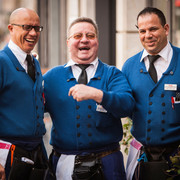Photos & Map
How would you like to arrive?
Details
Useful Information
Nearby
Rising to the sky-blue ribbed vault, a multitude of bones covers the walls of the chamber: vertebrae, leg, or pelvic bones, artfully arranged in ornaments or letters, fixed with small wires. To answer your likely first question at the sight: The bones are all real and human, in this largest ossuary north of the Alps, for which the church of St. Ursula in Cologne is famous. According to legend, they belong to 11,000 virgins who died as martyrs with Saint Ursula in Cologne. The Golden Chamber, a walk-in reliquary room, is dedicated to their veneration. Its sight will evoke emotions.
However, it is much more likely that the bones come from a Roman burial ground on which St. Ursula stands, which was uncovered during the construction and expansion of the city walls. Like some of the other 12 Romanesque churches in Cologne, St. Ursula thus builds a bridge to Roman Cologne. An intriguing story...
In addition to the bones, the Golden Chamber is adorned with 118 Ursula and relic busts – wooden busts adorned with gold and silver, often of serenely smiling women – and gold-leafed shelves like display cases filled with cloth-adorned skulls. What seems macabre today was the usual cultivation of memento mori in the 17th century and: a flourishing business. For in the Middle Ages, an Ursula bust filled with sacred bones was a popular souvenir that pilgrims took home from one of the 12 Romanesque churches in Cologne. Given the number of pilgrims who came to Cologne, the collection of bones from the Roman burial ground proved more than fortuitous to have enough relics in stock.
You can visit the Golden Chamber of St. Ursula at specific times – it’s best to check the current opening hours in advance, so you don’t find yourself before a closed chamber door.
Ursula stopped in Cologne on her pilgrimage and was blessed with a second vision, instructing her to stop again in Cologne on her return from Rome to Brittany, so that her life and that of her followers would be fulfilled. And it was fulfilled, for the Huns were conquering Cologne when Ursula and her virgins stood in their way. All the virgins met their martyrdom. Ursula followed a bit later than the others, as she first had to reject the Hun king Attila’s marriage proposal, after which she was fatally struck by an arrow.
However, during the night, the slain virgins appeared in Attila’s dream, and fearfully, he refrained from his plan to conquer Cologne. In gratitude for saving their city, the citizens of Cologne built a church over the graves of Ursula and her virgins: St. Ursula.
As is often the case with legends: there are no historical records for Ursula, the virgins, and their story, and there are many versions of it. Somewhere along the line, the number of virgins increased from 10 to 11 and 11,000, possibly due to a translation error. Even the “Clematius Inscription” often cited as the basis of the Ursula legend does not offer a reliable source but perhaps points to a true core of the legend.
Also, have a look at the mentioned Clematius inscription, probably from the 4th/5th century, which was embedded in the south wall of the long choir in the 13th century and is considered the earliest evidence of Christianity in Cologne.
However, it is much more likely that the bones come from a Roman burial ground on which St. Ursula stands, which was uncovered during the construction and expansion of the city walls. Like some of the other 12 Romanesque churches in Cologne, St. Ursula thus builds a bridge to Roman Cologne. An intriguing story...
Over 118 Reliquary Busts: A Popular Reliquary in the Middle Ages
In 1643, a wealthy merchant donated the Golden Chamber to create a larger space for the veneration of the relics. It remains in its original condition to this day and was untouched during World War II, making it unique alongside its valuable furnishings and the second most-visited church in Cologne after the Cathedral.In addition to the bones, the Golden Chamber is adorned with 118 Ursula and relic busts – wooden busts adorned with gold and silver, often of serenely smiling women – and gold-leafed shelves like display cases filled with cloth-adorned skulls. What seems macabre today was the usual cultivation of memento mori in the 17th century and: a flourishing business. For in the Middle Ages, an Ursula bust filled with sacred bones was a popular souvenir that pilgrims took home from one of the 12 Romanesque churches in Cologne. Given the number of pilgrims who came to Cologne, the collection of bones from the Roman burial ground proved more than fortuitous to have enough relics in stock.
You can visit the Golden Chamber of St. Ursula at specific times – it’s best to check the current opening hours in advance, so you don’t find yourself before a closed chamber door.
Legend of Saint Ursula
The legend goes like this: Once upon a time, there was a beautiful princess named Ursula who came from Brittany and preferred to devote her life to God rather than a husband. However, a nighttime vision convinced her otherwise, and she accepted a suitor’s proposal, on the condition that she could embark on a three-year pilgrimage to Rome with 10 virgins and that her pagan future husband would convert to Christianity. Seen it, done it.Ursula stopped in Cologne on her pilgrimage and was blessed with a second vision, instructing her to stop again in Cologne on her return from Rome to Brittany, so that her life and that of her followers would be fulfilled. And it was fulfilled, for the Huns were conquering Cologne when Ursula and her virgins stood in their way. All the virgins met their martyrdom. Ursula followed a bit later than the others, as she first had to reject the Hun king Attila’s marriage proposal, after which she was fatally struck by an arrow.
However, during the night, the slain virgins appeared in Attila’s dream, and fearfully, he refrained from his plan to conquer Cologne. In gratitude for saving their city, the citizens of Cologne built a church over the graves of Ursula and her virgins: St. Ursula.
As is often the case with legends: there are no historical records for Ursula, the virgins, and their story, and there are many versions of it. Somewhere along the line, the number of virgins increased from 10 to 11 and 11,000, possibly due to a translation error. Even the “Clematius Inscription” often cited as the basis of the Ursula legend does not offer a reliable source but perhaps points to a true core of the legend.
Regarding the Construction History
As the oldest Lower Rhenish three-aisled gallery basilica, St. Ursula was built around 1185. This construction was preceded by a ladies' convent around 922 and a predecessor building from late Roman times. World War II also affected St. Ursula, like many of the other 12 Romanesque churches in Cologne, and the repair work took a long time – until 1972. Besides the Golden Chamber as a highlight, St. Ursula houses valuable furnishings that alone make a visit worthwhile: such as the Baroque marble tomb of Saint Ursula and the Ursula cycle of 1456, which depicts 30 scenes of the Ursula legend on 24 wooden panels, the most extensive surviving cycle of its kind.Also, have a look at the mentioned Clematius inscription, probably from the 4th/5th century, which was embedded in the south wall of the long choir in the 13th century and is considered the earliest evidence of Christianity in Cologne.
Ursula Legend: Also Included in the Coat of Arms of Cologne
You may have wondered what the 11 black tears, drops, or – are they flames? – in the coat of arms of Cologne stand for. For the three crowns unmistakably refer to the Three Wise Men, whose relics lie only 650 meters from St. Ursula in the Cologne Cathedral – which is why they also adorn the entrance to the Tourist Information Center. With the Ursula legend, the mystery of the 11 ermine tails – for that is what the 11 black signs represent – reveals itself: They commemorate Saint Ursula and her 11 or 11,000 virgins who liberated Cologne from the Huns. Why ermine tails? Because Ursula came from Brittany, where it plays a significant role in legends and stories – the charming, white creature.Useful Information
Openings
Dayoff: Monday
Eligibility
for Groups
for families
for individual guests
Payment methods
Entrance Free
Parking facilities
The walk from Cologne Central Station to St. Ursula's Church takes about 8 minutes.
Nearby











